WWII GERMAN IRON CROSS - FIRST CLASS -
The Iron Cross has long been held as a symbol for bravery in combat, The Germans have been employing it
as an award since the 1800's. The Iron Cross employed during WWII is very similar to that used in
WWI.
The major differences between the two periods are the dates displayed in the lower arm of the cross
and the absecense of a Swastika in the WWI type.
|
The item featured here is a WWII German Iron Cross first class. The award was issued in a box
with a certificate. Additional accoutrements such as ribbons could be obtained and were authorized
for wear by the recipient of the Iron Cross.
The Cross was instituted on September 1st 1939.
There are three basic variations. The first design is the one covered here. A second design came with slightly
convex arms (Produced by Godet and Son of Berlin). The third design was produced for use by the Navy. This cross
has a Brass core which was chemically blackened.
There is a cloth version of the award. It came in a few different variations. The construction was very high
quality. The front has the appearance of the Iron Cross. The back is plain and often covered in paper. It is
possible that these items were private purchase. The actual reason for their creation is not certain. It makes
sense that they would be worn in occassions where the metal version would be too cumbersome.
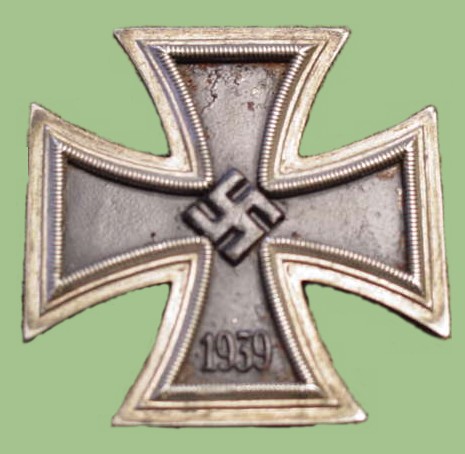
|
There were several versions of the Iron Cross.
- First Class Iron Cross - This award has a pin back and
does not hang from a ribbon.
- Second Class Iron Cross -
The award has a Award has an upper loop where a ring is attached allowing it to be
suspended via a ribbon. This is the award featured on this page.
- Knight's Cross of the Iron Cross - Introduced on September of 1939. Designed to bridge the gap between the
Iron Cross First Class and the Grand Cross.
- Knight's Cross of the Iron Cross with Oak Leaves - Introduced on 3 June 1940.
- Knight's Cross of the Iron Cross with Oak Leaves and swords - Introduced on 15 July 1941.
- Knight's Cross of the Iron Cross with Oak Leaves, swords and diamonds - Introduced on 15 July 1941.
- Knight's Cross of the Iron Cross with Golden Oak Leaves, swords and diamonds - Instituted on January 1945.
awarded to only one person. Hans Ulrich Rudel.
- Star of the Grand Cross of the Iron Cross - This is a prototype award.
- Grand Cross of the Iron Cross - Instituted on September 1st 1939. Identical to the Second Class Iron Cross
except that bigger.
|
CRITERIA FOR AWARD
The Iron Cross First class was awarded for : Distinguishingf oneself three or more times than required for the
Second Class award.
IRON CROSS DESIGN
The design of the award consisted of a cross with arms that get wider as they extend from the center. The body of the
cross is outlined by a ribbed ridge. It is placed about a quarter of an inch away from the edge of the cross. It follows
the contour of the body. The area inside the ridge is painted black. The outer perimeter is of silver color.
The back is solid and has no design. A heavy steel pin is hinged on one side. The other side has a catch that
helps secure the pin in the closed position.
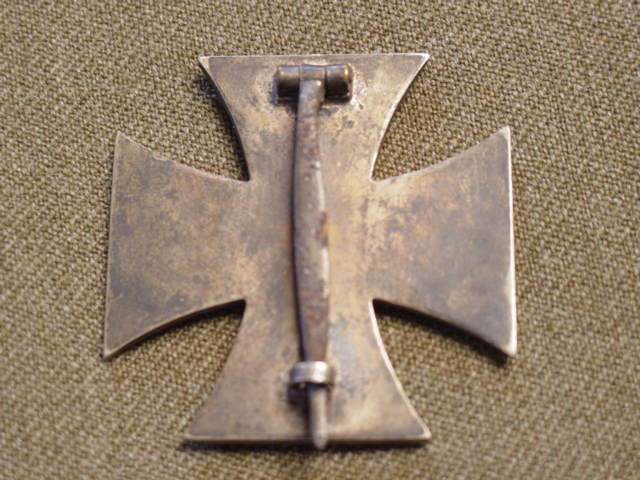
The back of the Cross featured on this page does not have any markings. However, there are many that did.
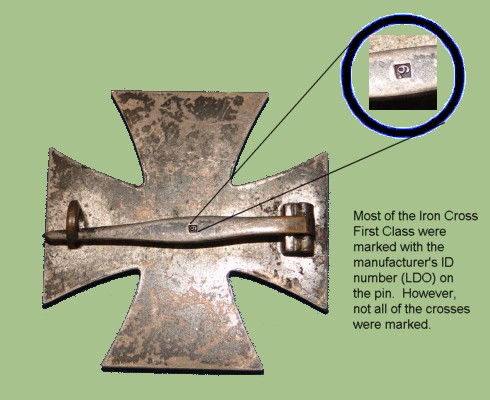 |
IRON CROSS MARKINGS
Like many other German badges and awards, the Iron Cross could be found with a manufacturer's marking on the
back.
The marking found is usually a number which is knwon as the
LDO Number .
This marking is stamped at the time of production and denotes the name of the company and its location.
In 1941 it was decided to create the Administration of German Orders Manufacturers ( deutschen Ordenhersteller),
known as the LDO. Its main purpose was to control the production of medals and orders. The LDO was directed by the
Fuhrer's Chancellery.
It is important to note that not all crosses were stamped. It is possible to find a Cross that has no markings
whatsoever.
|
|
This page is a recognition and identification guide for WWII German badges and awards. Multiple
detailed photos of a specific sample are provided. Descriptions point out clearly defined points
that should be noted.
One of the most commonly asked questions is "How much is my WWII German badge worth?". A price
guide is included here to address this question. The value of the badges and awards is reviewed
over a period of several years. A trend can be observed. The present worth of the German
badges in the collector's market is illustrated.
This service is provided free of charge to the visitor/enthusiast courtesy of
MilitaryItems.com,
a company dedicated to the preservation of military history and to providing quality military
antiques and collectibles to museums, institutions and the general public.
|
|
The award is composed of two identical crosses pressed together. A
vertical pin
is hinged at the top of the award. A catch is provided at the opposite end.
The body of the cross is outlined by a ribbed ridge. It is placed about a quarter of an inch away from the
edge of the cross. It follows the contour of the body. The area inside the ridge is painted black and has
a swastika in the center with the date 1939 just below. The outer perimeter is of silver color. The
cross is made of iron.
The Iron Cross first class is worn on the
tunic
by passing the pin throuigh loops (two or mote) sewn to the chest.
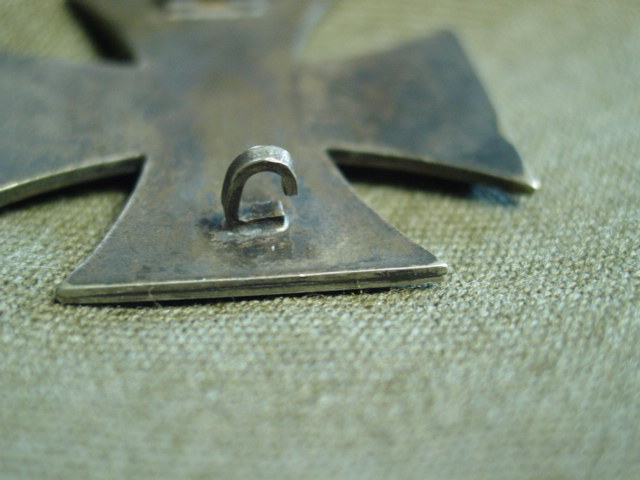
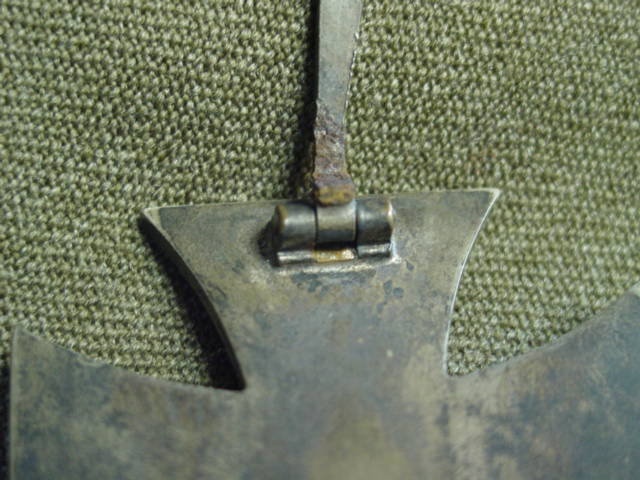
HOW THE IRON CROSS WAS PRESENTED
The Iron Cross First Class was issued in a box. There were several examples available. The one shown below is one
type. Black leather cover with the outline of an Iron Cross applied to the top in silver paint. The texture of
the cover is very nice. A hinge is exposed in the back. The top of the lid is vaulted.
The inside of the box has a padded silk liner on the top. The bottom section is Khaki in color. Very soft to the
touch. A cut-out is found in the center. This feature accomodates the back pin of the award. When stowed away the
award does not move very much due to the design of the case. The joint between the top and bottom of the case has
a white linen cover to hide the hinge.
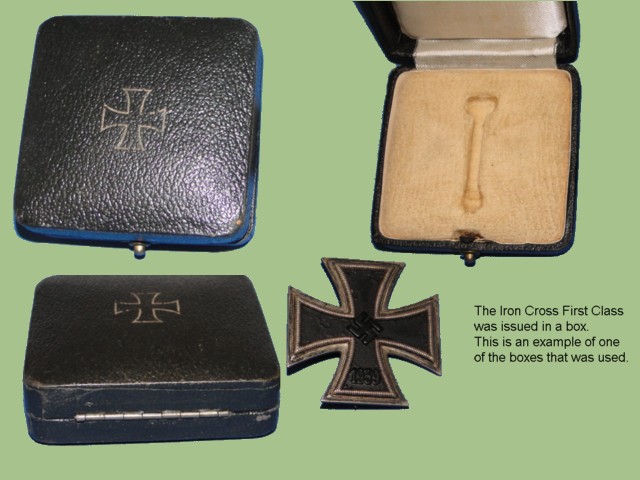
BY THE NUMBERS
It is hard to determine the exact number of Iron Crosses that were produced. However, thanks to the record keeping
maintained by the Wehrmacht, it is possible to find how many crosses were actually issued.
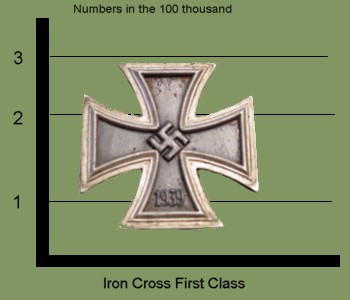 |
A total of 300,000 First Class Iron Crosses were awarded during WWII.
There were a total of 68,400,000 people living in Germany in 1939.
|
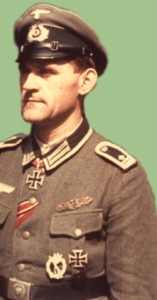
|
The actual number of Iron Crosses produced is greater than the number that was issue. It must be accounted that the armed forces would have a stock in hand so it could replace lost ones and issue new awards. In addition the factories were likely to have warehouses with inventory at hand. The Iron Cross was one of the awards most widely distributed during WWII.
COLLECTING IRON CROSSES
Collecting Third Reich memorabilia is a field that has been growing since the days the GI's rummaged around Europe
bringing back military souvenirs. German soldiers wore many of their awards on their uniforms when they went to battle.
Once the soldier was killed or captured, the American soldiers would take the awards as war trophies. Eventually all
these pieces came back to the United States where military history enthusiasts began to collect them.
|
"I am trying to figure out if I should get into collecting Infantry Assault badges."
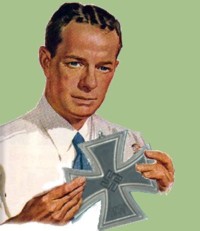 |
Determining which military badges to collect can be a challenging decision. The combination of availabiilty and
cost will often set the pace of what can be collected.
The adjacent table outlines some of the advantages and disadvantages of collecting the Infantry Assault badge.
|
|
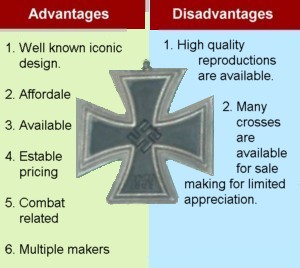
|
This award is currently being
reproduced.
It is becoming more difficult to be able to tell the fake ones from the real ones because the quality
of the reproductions is improving. The collector must become familiarized with the construction style
and materials employed in the manufacturing of this badge. Attention to the details is critical in
order to be able to determine the authenticity of the badge.
If you have an interest is seeing other badges and awards of the Third Reich, you can do so by going
to our
WWII German Badges and Awards
identification guide. Where we cover Heer (Army), Navy (Kriegsmarine) and
Air Force (Luftwaffe) items.
WWII GERMAN IRON CROSS 1st CLASS VARIATIONS |
The Iron Cross 1st class was produced by several manufacturers and in different configurations. The more examples of
a particular dagger that are examined the more knowledge is gained about the particular piece. Differences in
construction can be better appreciated. Markings on the suspension ring and other sections are better understood. The
overall knowledge about the Iron Cross First Class is expanded.
This section of the site provides several examples of the Iron Cross.
| 






